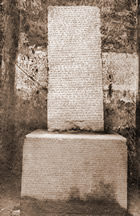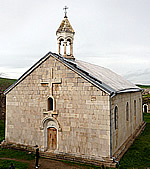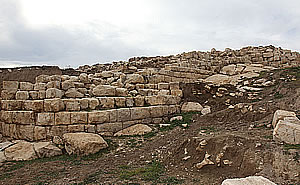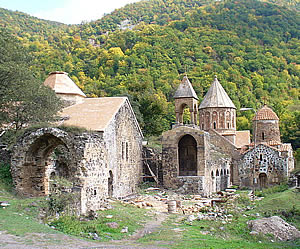History of Karabakh (part 1)
Artsakh and Karabakh
There are several popular etymologies of the name Artsakh. According to an old tradition, the Armenian forefather Hayk bestowed the country on Aramanyak, his first-born son. Aramanyak planted the land with countless trees and gardens. Subsequently, the country was named Ar-tsakh, meaning Woods of Aramanyak (“Tsakh” is Armenian for Woods, “Ar” is abbreviation for Aramanyak). Since Artsakh is a very wooded and mountainous area, another popular version identifies “Ar” with “Sar” (meaning “mountain”).
As for Karabakh, this name first appeared in some Persian texts in the late 14th century after the descent of wild Turkish nomadic tribes. “Kara” is Turkish for Black; “Bakh” is Turkish for Garden. Devastated after one of the Turkish invasions, the country was compared to “Black garden”.
Azokh
Just like the rest of Armenia, Artsakh was one of the earliest sites of human civilization. Undoubtedly, it also was one of the first areas of bronze, copper and iron smelting. The excavations in different parts of Artsakh revealed numerous settling places of early Paleolithic and Neolithic periods. Skeletal remains of a Neanderthal man were found in the Cave of Azokh.
Artsakh province of Greater Armenia
 A cuneiform inscription of King Sardur II discovered in Van, in 1916, mentions Artsakh as part of Urartu
A cuneiform inscription of King Sardur II discovered in Van, in 1916, mentions Artsakh as part of Urartu
Artsakh as a part of the Kingdom of Ararat (Urartu) is mentioned in the 8th century BC in cuneiform inscriptions of the King Sardur. Two centuries later, the Kingdom of Ararat was conquered by the Medes. Then the Kingdom of Ararat, which became Armenia, remained under the Persian dominion until regaining independence in the middle of the 2nd century BC. In 149 BC, King Vagharshak came to the Armenian throne beginning the period of the dynasty of Arshakids.
According to tradition, King Vagharshak carried out social reforms, reorganized the royal court and instituted a new feudal order. He appointed the Prince Aran, one of his vassals and descendant of the Armenian forefather Hayk, as governor of the Armenian eastern provinces. Because of his kind and good-hearted character, Aran was nicknamed Aghu (Armenian for kind, gentle). Since then the Armenian sources designate the vast domain of Aran as Aghuank (Albania in Greek and Roman sources), while the Persian texts rather used the name Aran. The Aghu’s domain also included the Artsakh Principality.
As a province of the Greater Armenia, Artsakh is mentioned in several ancient authors’ works, particularly in Strabo‘s Geography. In the 1st century BC, when Armenia became a powerful state, Tigranes the Great built the city of Tigranakert, one of the four cities of that name, near the present city of Aghdam.
Amaras
 Amaras Monastery, built in 4th century
Amaras Monastery, built in 4th century
In the early 4th century, Armenia was Christianized. In Artsakh, Gregory the Illuminator founded the first church near a small river of Amaras. Later in the 5th century it became famous monastery. After St.Mesrob invented the Armenian alphabet in A.D. 405, a large number of schools appeared in Artsakh, making the province one of the centers of Christian enlightenment and culture.
Aguank
In 387, Armenia was divided between the Persian and Byzantine Empires. The Persian part was then split into several satrapies, and the provinces of Artsakh and Outik were attached to Aghuank (Aran) satrapy. The Armenian satrapies were governed by marzpans. Since then the Aghuank appellation was mostly used by the Armenian chroniclers and historians to designate Artsakh and Outik provinces.
Among the other Armenian nobles, the Princes of Artsakh participated in the Anti-Persian uprising in A.D. 451 known as Vardanank. That was the first known war for freedom of worship in the history of the world.
Vachagan the Good
In the late 5th – early 6th centuries, Aghuank (i.e. the Armenian provinces Artsakh and Outik) was reinforced to the point that some of the rulers proclaimed themselves kings. The heads of Aguank Diocese, initially appointed by the Armenian Catholicoi, began to call themselves Catholicos of Aghuank. Aghvuank especially prospered under Vachagan the Good, descendant of Aran dynasty. The representatives of Aran family (or its brunches) conserved their leading role in the 7th and 8th centuries, when Aghuank with the rest of Armenia were under the Arab occupation. Artsakh was famous for its inaccessibility, so the region enjoyed relative peace as compared with other parts of Armenia.
The Arab invasions
However, the situation changed in the 9th century, when consecutive uprisings compelled the Arab rulers to take drastic measures in all parts of Armenia. In 852-854 Bugha, a cruel Arab commander, appointed by Caliph, invaded Armenia sowing death and destruction. He captured many of the Armenian grandees and then invaded Artsakh, where he met fierce resistance. Isaiah, the brave Prince of Artsakh was Bugha’s most uncompromising opponent. According to Thomas Ardzrouni, Bugha made 28 assaults in an attempt to take the fortress of Gtich, Isaiah’s residence. Finally, the Arabs subdued the country for a short period of time, but the Caliphate was forced to revise its policy towards Armenia.
Following the next decades, both Armenia and the eastern provinces gradually gained de facto independence. In 885, Ashot Bagratuni was proclaimed King of Armenia. At the same time, Gregory the Good was recognized King of Aghuank.
Gandzasar and Dadivank
Owing to its advantageous geographical location, Artsakh partly avoided the large-scale Seljuk invasion in the 11-12th centuries, as well as the Tatar-Mongolian invasions in the 13th century. The Armenian architecture reached its heights in Artsakh in the early 13th century. A number of outstanding monuments were built, of which the most sumptuous were the monasteries of Gandzasar and Dadivank. However, some of the churches were destroyed in the 14th century, when a number of Turkish nomadic tribes invaded Artsakh.
In the 15th century, the territory of Armenia became the scene of confrontation between the Ottoman Empire and Persia. Following the truce concluded in 1639, Artsakh with the rest of the Eastern Armenia became part of Persia.










